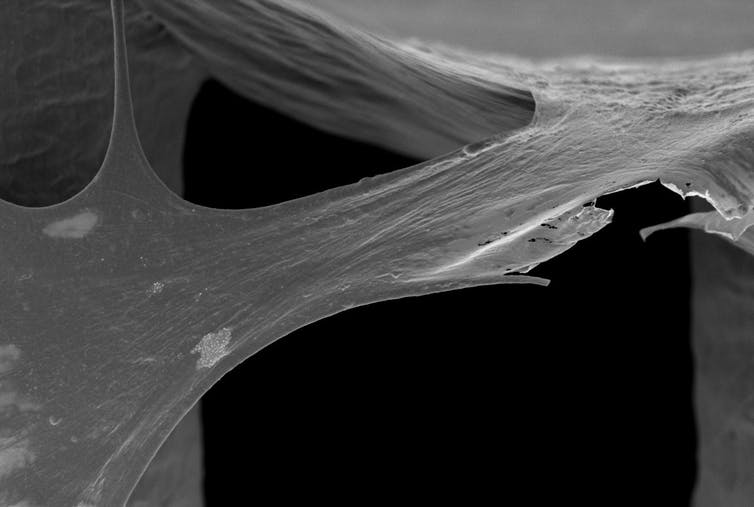“If you look at the way people were injured 100 years ago, 90% were the military and 10% were civilians. It’s now the other way around.” – Amer Shoaib
It is apparent that Paulo Bartolo was inspired on numerous levels in the creation of 3D-printed, modular parts meant to rebuild limbs blown off by weapons or amputated later. The Chair Professor on Advanced Manufacturing at University of Manchester, Bartolo lived in Mozambique in South-East Africa as a child. Experiencing the effects of a war-torn country—and even living for a month in a refugee camp—Bartolo now wants to put his biomedical expertise to valuable use for others in desperate need.
When Amer Shoaib, a consultant orthopedic surgeon at Manchester Royal Infirmary, visited the University of Manchester, Bartolo learned more about the devastation wreaked upon citizens by barrel bombs—and the challenges in helping injured refugees there. Used by the Syrian Air Force, barrel bombs are unfortunately very effective at hitting targets, filled with munitions that cause enormous explosions and are responsible not only for many fatalities but also lost limbs.
Such injuries don’t often form clean breaks, either, but are ragged at the perimeter. Bartolo states that such injuries would be difficult to treat, even with the best of medical care; in fact, upon Shoaib’s visit, Bartolo learned that, in many cases, there is no treatment available at all, due to risk of infection, and especially when the injured are living in refugee camps. Nearly two million people have been wounded in the civil war—and while amputation is traumatic on its own, other complications may follow, such as infection, risk of heart attack, and vulnerability in terms of wounds that heal slowly.

Andrew Weightman and Paulo Bartolo in the lab. (Photo credit: JillJennings/The University of Manchester)
Bartolo was seeking an easier, more affordable way to treat patients. He states that he now believes that he and his partners have met their goal with the design of 3D-printed “bone bricks,” which are able to fill the jagged areas. Fabricated with polymer and ceramic, Bartolo explains that the parts snap together “just like a LEGO brick.”
The bricks encourage bone regeneration while offering the necessary support. Afterward, the bricks dissolve.
“The idea is that the surgeon can open a bag of bricks and piece them together to fit that particular defect and promote the bone growth,” Bartolo says. “The bone brick prosthesis and paste will prevent infection, promote bone regeneration and create a mechanically stable bone union during the healing period.”
Bartolo shares data from the Turkish government, citing over $37 billion spent helping Syrian refugees. In hoping to make a contribution, Bartolo and his partners—Paulo Bartolo, Glen Cooper and Andrew Weightman—now have financial assistance from the Global Challenges Research Fund, an organization that offers resources to researchers seeking to address issues in developing countries. The project is also funded by the Engineering and Physical Sciences Research Council.
The partners visited Istanbul and spoke with lead collaborator Bahattin Koc, who helped them meet with other doctors who had personal experience treating refugees in the field.
“We hope that our bone bricks innovation can make a contribution to this crisis, helping to mitigate Turkey’s healthcare costs and also significantly improve the human cost of this crisis,” says Bartolo.
While the health issues that Syrian refugees face is exceptionally difficult, bone regeneration is a challenging area for doctors treating patients everywhere. A wide range of research projects have been performed in recent years, to include methods for improving bioprinting, experimentation for PLA scaffolds, and research into titanium.
What do you think of this news? Let us know your thoughts! Join the discussion of this and other 3D printing topics at 3DPrintBoard.com.
[Source / Income: ‘The Conversation’]Subscribe to Our Email Newsletter
Stay up-to-date on all the latest news from the 3D printing industry and receive information and offers from third party vendors.
You May Also Like
Gorilla Sports GE’s First 3D Printed Titanium Cast
How do you help a gorilla with a broken arm? Sounds like the start of a bad joke a zookeeper might tell, but it’s an actual dilemma recently faced by...
Nylon 3D Printed Parts Made More Functional with Coatings & Colors
Parts 3D printed from polyamide (PA, Nylon) 12 using powder bed fusion (PBF) are a mainstay in the additive manufacturing (AM) industry. While post-finishing processes have improved the porosity of...
$25M to Back Sintavia’s Largest Expansion of Metal 3D Printing Capacity Since 2019
Sintavia, the digital manufacturing company specializing in mission-critical parts for strategic sectors, announced a $25 million investment to increase its production capacity, the largest expansion to its operations since 2019....
Velo3D Initiates Public Offering in a Bid to Strengthen Financial Foundations and Drive Future Growth
Velo3D (NYSE: VLD) has been among a number of publicly traded 3D printing firms that have attempted to weather the current macroeconomic climate. After posting a challenging financial report for 2023,...































